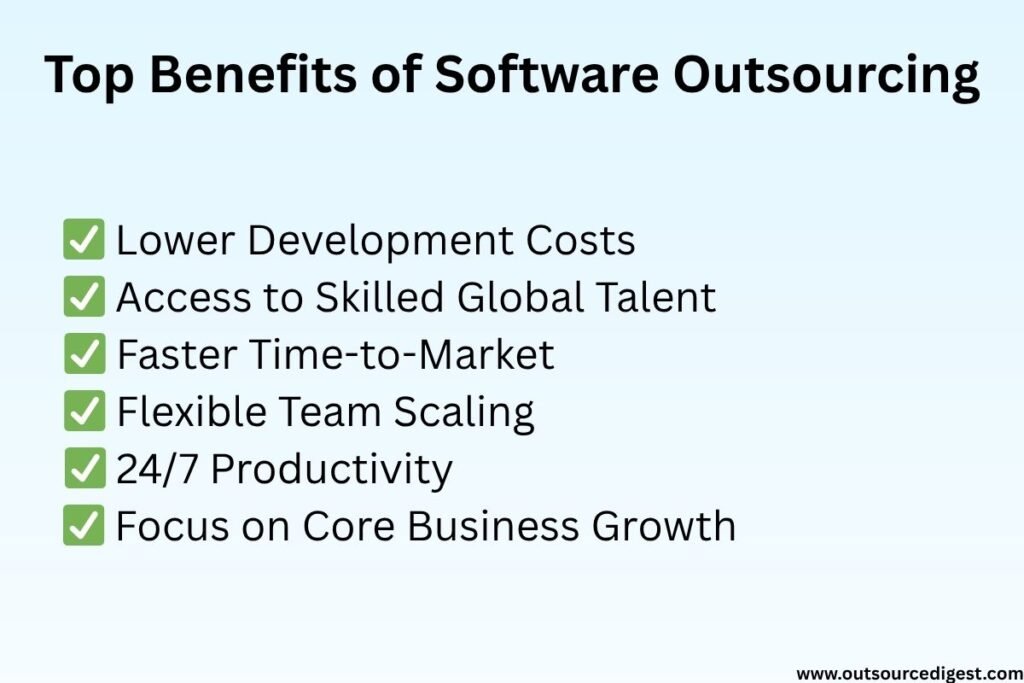Software outsourcing is quickly becoming a popular way for companies to build software efficiently and save costs. Instead of relying only on in-house teams, many businesses now work with external experts worldwide. This approach not only speeds up development but also offers access to skills that might be missing internally.
In this comprehensive guide, you’ll learn what software outsourcing really means, why it’s gaining so much attention, and what benefits and risks you should consider before getting started. Whether you’re a startup or a growing company, understanding this strategy can help you make smarter decisions.
What is Software Outsourcing?
Software outsourcing is the practice of hiring an external company or team to handle part or all of your software development tasks. Instead of building everything in-house, businesses delegate specific projects, such as web development, mobile apps, or backend systems, to third-party providers, often located in different countries or regions.

Software outsourcing helps companies reduce costs, access global talent, speed up time to market, and focus on their core business functions. Whether it’s through nearshore, offshore, or onshore partners, software outsourcing offers flexibility and scalability, especially for startups and growing businesses.
What Are the Real Benefits of Software Outsourcing?
Software outsourcing has become a go-to strategy for businesses aiming to scale efficiently and compete in a fast-paced digital world. From cutting costs to unlocking global talent, its benefits are both immediate and long-term.
For a complete overview, read: Top Benefits of Software Outsourcing for Startups and Enterprises

1. Cost Efficiency and Reduced Overhead
One of the biggest advantages of software outsourcing is cost savings. By working with teams in regions where labor is more affordable, companies can significantly reduce development costs without compromising on quality. Plus, there’s no need to invest in infrastructure, training, or full-time salaries—pay for what you need, when you need it.
2. Access to Top Global Talent
Outsourcing opens the door to a worldwide pool of skilled developers, designers, and IT professionals. Instead of being limited to local hires, you can work with experts who specialize in your tech stack, industry, or niche—no matter where they’re based.
3. Faster Time to Market
With dedicated outsourcing teams, projects can move faster. While your in-house team focuses on core tasks, the external team handles specific components of the project, helping you launch products quicker and gain a competitive edge.
4. Scalability and Flexibility
Need to ramp up during a product launch or scale down during a slow season? Software outsourcing gives you that flexibility. You can easily adjust your team size and workload without the long-term commitments of full-time hiring.
5. Focus on Core Business
Outsourcing allows your internal team to concentrate on strategic goals while external partners manage technical development. This clear division of responsibilities improves efficiency and keeps your business focused on what matters most—growth, innovation, and customer satisfaction.
6. Innovation Through External Expertise
Outsourcing partners often bring fresh ideas, new technologies, and industry best practices. Their outside perspective can lead to better solutions, improved processes, and more innovative outcomes.
Risks and Challenges of Software Outsourcing.
Software outsourcing offers many advantages, but it’s essential to be aware of potential risks to make informed decisions. Understanding these challenges helps businesses prepare and minimize setbacks.
1. Communication Barriers
Working with offshore teams often means dealing with different time zones, languages, and cultural nuances. Misunderstandings can delay projects or affect quality. Establishing clear communication channels and regular updates is key to overcoming this hurdle.
2. Quality Control Issues
Outsourcing sometimes risks inconsistent work quality, especially if the provider lacks proper standards or processes. It’s crucial to set clear expectations, agree on deliverables, and perform regular reviews to ensure quality stays high.
3. Data Security and Confidentiality
Sharing sensitive business data with an external partner always carries some risk. Without strict security protocols, your intellectual property and customer information could be vulnerable. Make sure your outsourcing partner follows robust data protection measures and signs NDAs.
4. Hidden Costs
While outsourcing can reduce costs, unexpected expenses may arise, such as additional management overhead, delays, or rework. Plan your budget with a buffer and maintain transparency with your outsourcing provider to avoid surprises.
5. Dependency on External Teams
Relying heavily on an outsourced team can create dependency risks, especially if the partner becomes unavailable or changes priorities. To mitigate this, maintain good relationships, have backup plans, and document knowledge internally.
6. Lack of Control
Outsourcing means handing over part of your project control to an external team, which can be challenging if processes aren’t clearly defined. Ensure detailed contracts and regular check-ins to keep the project aligned with your vision.
Recommended: Outsourcing Mistakes Every Company Should Avoid
Types of Software Outsourcing Services in 2025
Software outsourcing services come in many forms, helping businesses reduce costs, speed up development, and focus on core operations. Here’s a breakdown of the most in-demand types.
Custom Software Development Services
Outsourcing custom software development allows companies to build tailored solutions that meet unique business needs. This type of software outsourcing ensures a personalized approach and full control over functionality.
Web and Mobile App Outsourcing Services
Hiring external teams for web and mobile app development outsourcing brings access to experienced developers who can create cross-platform, scalable apps quickly and efficiently.
Outsourcing DevOps and Cloud Solutions
Many companies outsource DevOps and cloud services to enhance deployment speed, scalability, and infrastructure reliability—key benefits of software development outsourcing.
UI/UX Design Outsourcing
UI/UX outsourcing services help you design intuitive and visually appealing software. A strong user experience is essential for engagement, making this type of software outsourcing a critical investment.
Outsourced QA & Software Testing Services
Quality assurance is one of the most outsourced services in software development. External QA and testing teams ensure product stability through manual and automated tests, which are critical for success.
Software Support and Maintenance Outsourcing
Even after launch, software needs updates and support. Outsourcing support and maintenance ensures long-term performance and fast issue resolution, allowing your team to focus on innovation.
Outsourcing Models Explained (With Pros & Cons)
Choosing the right software outsourcing model is crucial for success. Each model comes with unique advantages and drawbacks, depending on your project’s scope, budget, and level of control required.
Onshore, Nearshore, and Offshore Outsourcing Models
These three models differ based on the location of your outsourcing partner.

Onshore Outsourcing (same country)
it means hiring a software development partner located in the same country as the client. It offers benefits like easier communication, cultural alignment, and similar time zones, but often comes at a higher cost compared to offshore options.
Pros: Easier communication, cultural alignment, legal familiarity
Cons: Higher cost compared to other models
Nearshore Outsourcing (neighboring or nearby countries)
Nearshore outsourcing refers to partnering with a software vendor in a nearby country, often within the same or close time zone. This model balances cost savings with better communication and cultural compatibility compared to offshore outsourcing.
Pros: Minor time zone differences, cost-effective, better communication than offshore
Cons: Limited talent pool compared to offshore
Offshore Outsourcing (distant countries like India, the Philippines, or Eastern Europe)
Offshore outsourcing involves hiring a software development partner located in a distant country, often across continents. It’s a cost-effective solution for accessing global talent, although it may require extra coordination due to time zone differences and cultural gaps.
Pros: Significant cost savings, large talent pool
Cons: Time zone gaps, cultural/language barriers
These models are core to any software development outsourcing strategy, especially when cost, communication, and time are key factors.
Staff Augmentation Model
Staff augmentation is an outsourcing model in which external developers or IT specialists are hired to fill specific talent gaps within an existing in-house team. These external professionals work under the client’s management and integrate directly into their workflows, offering flexibility and scalability without the need for permanent hiring.
Staff augmentation allows you to temporarily add external developers to your internal team.
Pros: Flexibility, control over the team, quicker onboarding
Cons: You still manage the project and workload
Ideal when you have a strong in-house team but need extra support for specific skills.
Dedicated Development Team Model
The dedicated team model involves outsourcing an entire team of software professionals who work exclusively on a client’s project. While the vendor handles administrative tasks, the client retains full control over the project direction and priorities. It’s ideal for long-term development needs with evolving requirements.
This model gives you access to a full team that works exclusively on your project.
Pros: High commitment, better collaboration, scalable long-term
Cons: More expensive than staff augmentation
Best suited for long-term projects where consistent team involvement is key.
Project-Based Outsourcing Model (Fixed Price & Time and Materials)
In the project-based outsourcing model, the client delegates a complete software project to an external team. The outsourcing vendor is responsible for delivering the final product based on agreed specifications, timelines, and budgets. This model is best suited for well-defined, short-term projects.
Fixed Price Contract
The fixed-price model involves setting a predetermined cost for the entire project. The outsourcing vendor commits to delivering the project within an agreed budget and timeline. It works well for small or clearly defined projects with minimal changes expected during development.
Pros: Predictable costs, ideal for small or well-defined projects
Cons: Inflexible to changes mid-project
Time and Materials Contract
The time and materials model allows clients to pay for software development based on the actual time and resources spent. It offers flexibility for projects with changing scopes or uncertain requirements, as billing is based on hourly rates and ongoing effort.
Pros: Flexibility, pay for actual work done
Cons: Cost can rise if the scope isn’t managed
These models are perfect for startups and companies testing new ideas without long-term commitment.
Want to explore all models? Check out our guide on Top Software Outsourcing Models Explained (With Examples).
How to Choose the Right Outsourcing Destination in 2025
Finding the ideal software outsourcing destination in 2025 is more than just comparing prices—it’s about balancing cost, talent, time zones, and communication.
Here’s a breakdown of the top regions dominating the global outsourcing scene:
Eastern Europe: Poland, Ukraine, Romania
Average hourly rates: $30–$60
Pros:
- Strong technical education systems
- High English proficiency
- Small time zone difference from Western Europe
Cons:
- Slightly higher costs than Asia
- Political instability in some regions
Eastern Europe is ideal for companies looking for quality code, cultural alignment, and minimal communication issues.
Asia: India, Vietnam, Philippines
Average hourly rates: $15–$40
Pros:
- Huge talent pool
- Extremely cost-effective
- Widespread experience with global clients
Cons:
- Time zone differences (especially for US clients)
- Varying levels of English fluency
- Occasional quality inconsistency
Asia remains a popular choice for companies focused on reducing development costs while accessing experienced developers.
Latin America: Mexico, Brazil, Colombia
Average hourly rates: $25–$55
Pros:
- Time zone alignment with North America
- Solid technical skills and a growing IT industry
- English fluency is improving steadily
Cons:
- Limited availability of niche skills in some regions
- Economic volatility
Latin America is great for US businesses seeking nearshore software outsourcing with real-time collaboration.
Africa Rising: Egypt, Nigeria, Kenya
Average hourly rates: $20–$40
Pros:
- Emerging talent markets with government tech initiatives
- English is widely spoken in many regions
- Growing reputation in mobile and web development
Cons:
- Less proven track record compared to Asia or Eastern Europe
- Infrastructure issues in some areas
Africa is an exciting, rising player in the global software development outsourcing space, offering innovation and affordability.
Final Thoughts
When choosing your outsourcing destination, weigh more than just cost. Consider time zone overlaps, developer skill levels, and the ease of communication. A well-matched partner can significantly boost your product quality and speed to market.
Step-by-Step Guide to Outsourcing Software Development
Outsourcing software development can bring tremendous value to your business—but only if you follow the right steps. Here’s a practical, step-by-step guide to help you make smart, strategic outsourcing decisions in 2025.
1. Define Your Project Scope and Business Goals
To begin with, you need to outline what you want to build, the problems it solves, and your long-term objectives. Having a solid scope helps avoid misunderstandings and ensures you attract the right partners from the start.
2. Choose the Right Software Outsourcing Model
Once your goals are defined, the next step is selecting the right outsourcing model. Whether it’s staff augmentation, a dedicated team, or a fixed-price project, the right fit depends on your budget, desired control, and project flexibility.
3. Shortlist the Right Vendors
Now that you know what you need and how you plan to approach it, it’s time to identify potential vendors. Look into their tech stack, past projects, reviews, and industry expertise. In addition, ensure they align with your company culture and time zone for smoother collaboration.
4. Ask the Right Questions During Interviews
Before making a final decision, conduct detailed interviews with your shortlisted vendors. Ask about their development processes, handling of deadlines, flexibility with change requests, and how they maintain code quality. Moreover, evaluate their communication skills—clear, open communication is essential.
5. Sign Contracts and NDAs
Once you’re confident in your choice, make the agreement official. Sign contracts that clearly define deliverables, milestones, payment schedules, and responsibilities. NDAs are also critical to protect your intellectual property and business ideas.
6. Kick Off the Project and Manage Effectively
With everything in place, kick off the project with a detailed online meeting. Set communication norms, define sprint cycles or deadlines, and agree on tools for collaboration like Jira, Trello, or Slack. Furthermore, keep communication open throughout the project lifecycle.
7. Continuously Review and Optimize
Lastly, don’t treat outsourcing as a one-time decision. Continuously review progress, provide feedback, and adjust your approach as needed. As a result, you’ll improve both the development process and the long-term partnership quality.
How Much Does Software Outsourcing Cost in 2025?
If you’re planning to outsource software development in 2025, one of your first questions will likely be: how much does it really cost? Let’s break it down by region, provide smart budgeting tips, and highlight hidden costs you should watch out for.
Hourly Rate Comparisons by Region
Rates vary greatly depending on the region and developer expertise. Here’s a general breakdown of average hourly rates in 2025:
- Eastern Europe (Poland, Ukraine, Romania): $35–$65/hour
- Asia (India, Vietnam, Philippines): $20–$50/hour
- Latin America (Brazil, Mexico, Colombia): $30–$60/hour
- Africa (Egypt, Kenya, Nigeria): $25–$45/hour
- Western Europe & North America: $80–$150/hour
As you can see, outsourcing to regions like Asia or Eastern Europe can help reduce your overall costs while still offering solid expertise.
Budget Planning Tips for Outsourcing Software Development
To keep your outsourcing project financially on track, start by estimating the total number of development hours. Then, add a buffer of at least 15–20% for unexpected changes or delays.
Also, prioritize features by value. Not every feature needs to be built right away. This helps you stick to your budget while still delivering a functional product.
Finally, choose vendors who offer transparent pricing and flexible payment models. That way, you stay in control of your cash flow throughout the project.
Hidden Costs to Consider
Outsourcing isn’t just about hourly rates—there are hidden costs too. These may include:
Communication delays due to time zone differences
Project management tools or software licenses
Legal and compliance fees when dealing with cross-border contracts
Quality assurance and rework costs if the initial code isn’t up to par
By planning ahead and understanding these extras, you’ll avoid unpleasant surprises and maximize your return on investment.
Small vs. Large Outsourcing Companies: Which Should You Choose?
Choosing the right outsourcing partner can be tough. One of the biggest decisions you’ll face is whether to go with a small boutique firm or a large enterprise-level outsourcing company. Each option has its strengths and trade-offs. Let’s explore both to help you make the right call.
Pros and Cons of Small Outsourcing Companies
Pros:
- Personalized attention: You’ll likely work directly with the founders or senior developers.
- More flexibility: Smaller teams adapt quickly to changes in your project.
- Lower cost: Overhead is lower, so pricing tends to be more competitive.
Cons:
- Limited capacity: May struggle with very large or complex projects.
- Fewer resources: Might lack full-time QA, DevOps, or support teams.
- Scalability challenges: Team size may not grow as fast as your project needs.
Pros and Cons of Large Outsourcing Companies
Pros:
- Full-service offering: Includes developers, designers, QA, DevOps, and PMs under one roof.
- Scalable teams: Can quickly ramp up or down based on your project size.
- Proven processes: Strong project management and security practices in place.
Cons:
- Higher cost: You’re paying for infrastructure and layers of management.
- Less flexibility: Processes may be rigid and slower to adapt.
- You may feel like a number: Smaller clients might not get priority attention.
When to Choose Boutique vs. Enterprise
Go boutique if:
- You’re a startup or SME with a tight budget.
- You need a highly customized, niche product.
- You want close, hands-on collaboration.
Go enterprise if:
- You’re building a large, complex platform.
- You need guaranteed support, security, and scalability.
- Your budget allows for a premium service.
Real-World Example
A U.S.-based startup launched its MVP with a boutique firm in Ukraine. They got fast feedback, close collaboration, and launched in 4 months on a small budget.
Later, as they scaled, they switched to a large outsourcing partner in Poland for stability, security, and a 24/7 support team.
Top 10 Questions to Ask Before Hiring a Software Outsourcing Partner
Choosing the right outsourcing partner isn’t just about price or skillset—it’s about trust, communication, and long-term success. To make the best decision,
Here are 10 essential questions you should always ask before signing any contract:
- What’s your experience with similar projects?
You want a team that understands your industry or business type. Ask for examples, case studies, or similar apps they’ve built.
- Can you share client references or testimonials?
Hearing from past clients gives you insight into the company’s reliability, communication, and delivery style.
- What is your tech stack and core expertise?
Make sure their technology capabilities match your project’s needs—whether it’s React, Flutter, Python, or something else.
- How do you ensure quality and testing?
Ask about their QA process, test automation, and how they fix bugs. This shows their commitment to delivering high-quality software.
- How do you handle project communication?
Clear, regular communication is critical. Find out what tools they use (Slack, Zoom, Trello), how often they provide updates, and if they work in your time zone.
- What security measures do you take?
Make sure they follow strong data protection practices, offer NDAs, and understand compliance standards like GDPR or HIPAA if needed.
- What happens if a developer leaves mid-project?
It’s important to know how they handle staff turnover. Do they have backup resources? How fast can they replace someone?
- What is your pricing structure?
Understand if it’s hourly, fixed-price, or time and materials. Also, ask if there are any hidden costs like onboarding, support, or code handover.
- Will I own the source code?
Ensure the contract gives you full ownership of the code, design, and all intellectual property after the project is complete.
- How do you manage project timelines and changes?
Ask about their project management approach, how they track milestones, and how they handle unexpected delays or feature requests.
If you need more answers, please check our FAQ hub.
Real Case Studies & Success Stories
Understanding how companies actually benefit from software outsourcing helps turn theory into action. Here are two real-world examples showing how outsourcing made a big impact in both speed and savings.
Example 1: How a U.S. Startup Launched an MVP in Just 90 Days with Nearshore Outsourcing
The Challenge:
A tech startup based in Austin, Texas, had an idea for a SaaS platform but lacked the internal team to build it quickly. They needed to validate the idea fast, with a limited budget and time.
The Solution:
They chose to work with a nearshore development team in Colombia, known for their time zone compatibility and strong English skills. The team used Agile sprints and collaborated daily using Slack and Jira.
The Result:
Within 90 days, the MVP was live. The startup was able to launch, gather user feedback, and secure its first round of funding—all without hiring a single in-house developer.
Key Takeaways:
- Nearshore outsourcing reduces communication friction.
- Time zone alignment can speed up development cycles.
- Perfect for startups needing quick MVPs.
Example 2: How an Enterprise Saved $500K Annually with Offshore Outsourcing in India
The Challenge:
A U.S.-based enterprise was spending heavily on maintaining its internal development team for ongoing software maintenance and upgrades.
The Solution:
After reviewing several vendors, they partnered with an offshore outsourcing company in India. The offshore team took over ongoing backend development, bug fixes, and legacy system support.
The Result:
With lower hourly rates and optimized resource allocation, the company saved over $500,000 per year, without compromising on code quality or delivery speed.
Key Takeaways:
- Offshore outsourcing can deliver significant cost savings.
- Choosing the right team helps maintain high-quality standards.
- Great for long-term support and scaling.
Final Thought:
As you can see, outsourcing isn’t just a budget hack—it’s a smart strategy for both startups and enterprises when done right. Whether you need speed, savings, or skills, there’s a model that fits.
Final Thoughts: Is Software Outsourcing Right for You in 2025?
Software outsourcing can be a game-changer—but it’s not for everyone. Before you take the leap, it’s important to understand when it makes sense and when it might not be the best fit. Let’s wrap up with a quick summary to help you decide.
When Software Outsourcing Makes Sense
- You need to move fast. Startups and businesses with tight deadlines can benefit from an external team that’s ready to go.
- You’re on a limited budget. Hiring full-time developers can be expensive. Outsourcing gives you access to global talent at lower costs.
- You lack in-house expertise. Whether it’s AI, DevOps, or mobile apps, outsourcing gives you access to specialists without long-term hiring.
- You want to focus on your core business. Freeing up internal resources lets you concentrate on growth, marketing, or customer support.
When to Avoid Software Outsourcing
- Your project involves highly sensitive data. If security is your top priority and you don’t have strong legal protections in place, outsourcing might be risky.
- You need constant, in-person collaboration. Some projects require real-time brainstorming or physical proximity that remote teams can’t offer.
- You don’t have clear requirements. Outsourcing works best when you know exactly what you want. Vague goals can lead to miscommunication and wasted effort.
What to Do Next
If you think outsourcing might be right for your business, here’s what you can do:
- Go back to your goals. What are you trying to achieve? Speed, savings, or scalability?
- Review the models and destinations. Pick the combination that best fits your timeline and budget.
- Start small. Try a pilot project with a trusted partner before going all in.
Bottom Line
In 2025, software outsourcing will be more flexible and powerful than ever. With the right approach, it can help you build faster, smarter, and more affordably. However, it’s not a silver bullet. Think carefully, plan ahead, and choose the path that aligns with your goals.







